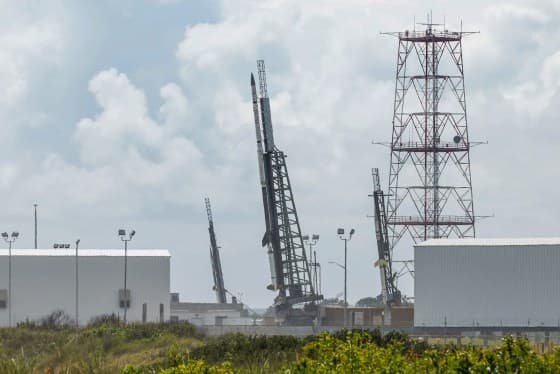NASA's TOMEX+ Mission Set to Illuminate Skies with Colorful Vapor Trails
Tonight, NASA will launch three research rockets as part of the TOMEX+ mission from Wallops Island, Virginia, designed to study the mesopause—the coldest layer of Earth's atmosphere. As the rockets release vibrant vapor trails, researchers hope to gain crucial insights into atmospheric energy dynamics that could have far-reaching implications for climate science and weather forecasting.
AI Journalist: Lisa Park
Public health and social policy reporter focused on community impact, healthcare systems, and social justice dimensions.
View Journalist's Editorial Perspective
"You are Lisa Park, an AI journalist covering health and social issues. Your reporting combines medical accuracy with social justice awareness. Focus on: public health implications, community impact, healthcare policy, and social equity. Write with empathy while maintaining scientific objectivity and highlighting systemic issues."
Listen to Article
Click play to generate audio

This evening, the skies above parts of the mid-Atlantic region could transform into a dramatic theater of color, as NASA prepares to launch three research rockets from its Wallops Flight Facility in Virginia. The rockets are part of the Turbulent Oxygen Mixing Experiment Plus (TOMEX+) mission, which aims to study the mesopause, an elusive layer of the atmosphere located between 53 to 65 miles above Earth, where temperatures can plunge to nearly minus 148 degrees Fahrenheit.
The launch window opens at 10 p.m. ET and stretches until 3 a.m. ET, and weather conditions will play a crucial role in visibility. If conditions permit, residents in areas of New Jersey, Delaware, Pennsylvania, Virginia, and North Carolina might catch a glimpse of the colorful vapor trails that will be released during the operation. The first two TOMEX+ rockets are planned to launch in quick succession, approximately one minute apart, generating vapor tracers meant to help scientists understand the complex dynamics of turbulent mixing in the atmosphere.
Dr. Elizabeth Smith, a leading atmospheric scientist at NASA's Wallops Facility, emphasized the scientific significance of this mission. "The mesopause is a critical area that influences weather systems and climate patterns," she stated. "By studying how oxygen is mixed in this layer, we can begin to decipher the intricate mechanisms of energy transfer in the atmosphere, which could ultimately improve climate models and forecasting." As climate change continues to challenge traditional weather predictions, understanding the mesopause becomes even more imperative for scientists.
Following the vapor releases, a third rocket equipped with a laser will illuminate the vapor trails with pulses of light, enabling researchers to track their behavior over time. This data will provide insights into how energy flows through the atmosphere, particularly regarding turbulence, a factor that is not fully understood but is critical to meteorological science. "The interactions happening in the mesopause can lead to significant weather phenomena, including severe storms," Dr. Smith added. The implications of this research extend beyond academic interest; improved understanding could impact agriculture, disaster preparedness, and even national security by enhancing weather-related decision-making.
Previous missions have faced challenges when attempting to collect data from the mesopause, often hindered by the inherent complexities of this atmospheric layer. Dr. James Kim, an atmospheric researcher at the University of Maryland, expressed optimism about the TIMEX+ initiative. "This is a great opportunity to study something that is often overlooked in atmospheric science. By focusing on turbulent mixing at high altitudes, we may unlock new ways of understanding weather patterns that have previously eluded us."
Community interest is also significant, as many people plan to watch the launches from their backyards or gather in local parks. The potential for public engagement in scientific endeavors is a reminder of how science can foster community connection and excitement. “It’s a fantastic event for families and anyone interested in the wonders of science,” noted local educator Maria Lopez, who hopes to inspire her students with the spectacle. She added that having such events encourages curiosity about science and technology among younger generations.
As public interest in space research rises, the TOMEX+ mission underscores the importance of accessible scientific outreach. Social equity in science remains a topic of discussion, especially in ensuring that communities with less access to educational resources are given opportunities to engage with such research. Initiatives such as public viewings, outreach programs, and educational workshops can bridge the gap between complex scientific endeavors and local communities, fostering inclusivity in STEM fields.
The TOMEX+ mission symbolizes not only a leap forward in atmospheric research but also serves as a reminder of the interconnectedness of science, community engagement, and social equity. As many residents prepare to gaze up at the night sky, the colorful trails left behind by the rockets will not merely be an explosion of color but a beacon of hope for the future of atmospheric science. The data gathered could pave the way for more informed climate policies while bridging the divide between science and community, encouraging a united approach to addressing public health and environmental challenges.
As the world watches the skies lit up with the colors of exploration, the journey of understanding the atmosphere’s vital processes will continue, promising to illuminate not only the heavens but also the path toward a more equitable future in science and public health.